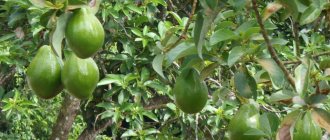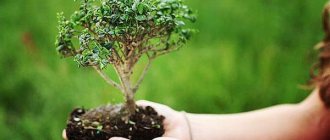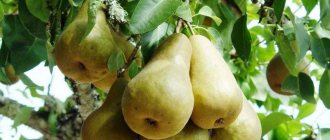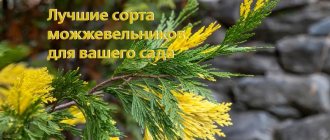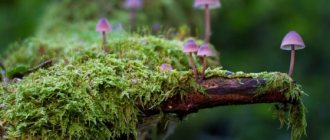Home Country garden
The coniferous yew tree grows very slowly - in the first 6-7 years after planting, the annual growth does not exceed 10 cm. This insignificant drawback is fully compensated by the simply fantastic life expectancy of these giants. There are descriptions of yew plants dating back thousands of years. And according to one legend, the Fortingale yew in Scotland grew during the life of Pontius Pilate.
- 2 Yew berry and its varieties
- 3 Other types and varieties of yew
- 4 Conditions for growing yew, planting and care in open ground
4.1 Video: Planting yew berry
- 4.2 Video: Yew in landscape design
Description of the yew tree
Evergreen yews are trees, less often shrubs. They grow up to 20 meters. The trunks are smooth, covered with brown bark with shades of red. The branches are very elastic, with beautiful flat needles.
A distinctive feature of the species is its slow growth. In 20 years, the tree will barely be able to approach two meters in height. But his life lasts for several thousand years.
Interesting. The oldest yew tree is over 4000 years old. It grows in Scotland, and according to legend, it was this tree that saw Pontius Pilate spend his childhood.
The yew bush is very fluffy and may have several tops.
- Yew has a powerful root system, and this gives the tree the ability to cling to any soil.
- The needles are dark green, up to 35 mm.
Flowering occurs in mid-spring (April), fruits ripen in mid-autumn (October). Single cones.
Interesting. The plant is poisonous. In the old days, when poisons were the solution to problems at any level, yew wine cups were used to quickly eliminate an opponent. Death came quickly.
Types of yew
The Tisov family unites 8 species of conifers.
Canadian yew or Taxus canadensis
It grows in the forests of the American continent. This species is in the form of a bush no more than two meters. The stems are short and have many needles. The front side of the needles looks green with some yellowness. And its lower part has a light green pigment with white veins. Can withstand frosts down to -35C°.
Taxus cuspidata (spiked yew)
The species is listed in the Red Book and is protected by law. Found naturally in China and Japan. Often reaches a height of ten meters, there are individual representatives of 20 meters in height.
- The crown of the pointed yew has an irregular shape due to horizontally located branches.
- The leaf blade at the top is dark green, looks almost black. The lower part of the needles has a lighter color.
- Seeds are oval shaped. Like the previous representative of the Taxus cuspidata family, it is resistant to low temperatures.
Interesting. The Egyptians called yew the tree of death - they made sarcophagi from it.
Short-leaved yew (Taxus brevifolia)
The USA and Canada are his home. Yew can grow up to 25 m, and can also be a shrub form - no more than five meters, hanging branches. The needles are pointed, green with a yellow tint. The shape of the seeds is ovoid.
Yew berry, Taxus baccata
The most famous species of this family. Habitat: Türkiye, Western Europe, Caucasus. Prefers mountains. Grows up to 20 meters and higher. Spreading and lush crown. A peculiarity of this yew is that the bark peels off as the tree matures. The seeds are red.
Taxus average
Taller than the previous representative of the family. The branches become reddish as they age. Characterized by resistance to adverse weather conditions.
Short-leaved yew (T. brevifolia)
Homeland - American northern continent. Habitats: mountain slopes, gorges. In this species you can find both giants - up to 25 meters, and relative dwarfs, which barely reach 5 meters. It grows very slowly. The branches hang down. At an advanced age, the bark may come off in layers.
- Interesting. By the 15th century, the yew was in danger of being completely destroyed due to the barbaric attitude of people.
- Between 1521 and 1567, up to 1 million two-meter-long yew logs were exported from Austria and Bavaria.
- The population of these giants was lost forever.
They began to produce very expensive and rare furniture from the remains.
Yew berry and its varieties
Yew berry in the photo
Yew berry, or European , can grow as a fairly large tree or shrub. The largest yew trees grow in the Caucasus - up to 27 m in height. They have an ovoid-cylindrical, multi-peaked, rather dense crown. The needles are dark green and shiny.
The berry is bright red, surrounding the seed to the very top.
The cultural history of this yew goes back thousands of years. Currently, it has more than a hundred different forms, many of which can grow in our country.
The most interesting varieties of yew berries are:
Yew "Dovastoniana" in the photo
“Dovastoniana” - reaches a maximum height of 5 m. The crown is quite dense and spreading. The form is widely known and popular all over the world. Used in a variety of ways: singly and in groups, including for curly haircuts;
Yew "Fastigiata" in the photo
"Fastigiata" - has a wide columnar crown, reaching a height of 5 m, and is quite frost-resistant.
Yew like a hedge in the photo
"Semperaurea" - grows in the form of a dense bush with shoots up to 2 m high. The needles are about 2 cm long, golden yellow. A famous and popular shape with an unusual coloring. Used for single planting, hedges;
Yew "Compacta" in the photo
"Compacta" is a slow-growing form with an oval or cone-shaped crown with raised branches and dark green needles. Good for small alpine slides.
Habitat
The places where yew grows naturally are determined by the specific species. Thus, short-leaved yew grows in Canada and the northern United States.
Yew berry is widespread throughout almost all of Western Europe; it can be found in the Carpathians, the Caucasus, Syria, and Asia Minor.
- Pointed yew grows in East Asia. In Russia, yew grows in the Southern Crimea - this is the well-known berry yew, and also on the Kuril Islands there is a pointed yew.
- In the Far East, yew is found in isolated specimens. However, there may also be small forests. Such forests, for example, can be found on the Kievka and Avvakumovka rivers.
- There are a large number of yew trees on the Kuril Islands; on Kunashir there is a giant tree of eighteen meters and a girth of more than a meter. Other islands in the area are also inhabited by yew trees. But the center of habitat of this plant is Petrov Island, on which there is a yew forest
But the largest place where the tree grows is the Batsar Gorge in Kakheti. The area of pure yew and mixed yew-beech forests is more than 207 hectares; there are more than 13,000 old yew trees and about 223,000 relatively young ones that have not yet reached the age of one hundred.
The largest specimens are located in the Batsarsky Nature Reserve. And some of them reach 165 cm in diameter and 32 m in height. The approximate age of these giants is 1700-1800 years.
Description of the coniferous plant yew
Coniferous plant Yew in the photo
Yew is a very valuable coniferous species. This is the only tree that can withstand full shade. It is easier to cut than other conifers to form a crown.
There are 8 types of yew known in nature, photos and descriptions of which are presented on this page. They are all small evergreen coniferous trees and shrubs native to the temperate to tropical zones of the Northern Hemisphere. Two species of yew coniferous plants are found in Russia, one in the Caucasus, the other in the Far East. Both are most in demand as ornamental shrubs and have many dozens of original forms.
The length of the needles is usually 2-3 cm, the width reaches 0.3 cm. Yews are monoecious and dioecious plants belonging to the group of gymnosperms, like other conifers. But yew fruits are not at all like the cones of pine and spruce trees. They have the appearance of berries, the seed of which is almost completely hidden by the fleshy pericarp.
The following is a description of the various types of yew trees and their varieties.
Planting and care
If desired, you can grow yew in your own area.
- The main thing is to decide on the right variety.
- In order for the seedling to take root and please the gardener with its appearance, you must adhere to some rules.
Choose the right landing site
Preference should be given to a shady place free from other plants.
Choose the right soil
The best soil for a seedling will be a turf layer + peat + sand. For the proper development of a young tree, alkaline or slightly acidic soil is required.
Landing
The distance between trees should be 2.5 m. The root collar is at ground level.
- The planting hole is about 70 cm.
- During the season, one watering is carried out at the rate of 15 liters per tree. Do not over-moisten the soil lump!
Fertilizers
Periodically apply special fertilizers for coniferous trees.
Wintering
Young trees should be covered for the winter to avoid freezing, branch breakage, etc.
Where is yew used?
Yew wood is very beautiful when cut, and any woodworker will say that it is a pleasure to work with it.
Interesting. The oldest wooden artifact is yew spears, which are 150 thousand years old.
- According to legend, Robin Hood wielded a bow made from yew wood.
- The wood practically does not rot. When water is exposed to wood for a long time, it turns purple and then turns black.
- A very valuable and expensive finishing material. Today it is very rare.
- The bark, leaves, and seeds are used in folk medicine.
Actively used in landscape design.
Fact. Taxane alkaloids obtained from the plant are part of the anticancer drugs Docetaxel and Paclitaxel, which are used to treat cancer.
LiveInternetLiveInternet
Thursday, October 25, 2007 17:01 + to quote book Taken from https://www.mythomania.ru/ Yew (Taxus lat., Iúr Irish., Iubhar Gael., Ywen Wall., Ivenenn Breton., If French., Idegran (Swedish, Eibe (German)) is a genus of evergreen coniferous trees and shrubs with numerous decorative fruits - bright red berries. Yew is extremely durable and grows very slowly. Its average increase in thickness is 1 mm per year. It reaches a height of 10-20 m, in some cases higher, the maximum recorded trunk diameter of 5 m was reached in 4000 years. Yew bush is a common ornamental plant in the classic English garden. Trimmed yew trees are used to create hedges, decorative sculptures and labyrinths. The wood, bark, shoots, needles and seeds of yew contain an alkaloid called taxin, which is poisonous to humans and animals, which has a paralyzing effect on the heart, causing convulsions and respiratory arrest. An extract of 50 grams of yew needles is enough to kill a person. Only the pulp of the berry is edible and pleasant to taste - it serves as food for birds that carry yew seeds. According to legend, poison was made from yew, which was used by witches. It is known that Celtic archers smeared yew poison on the tips of their arrows. The concentration of poison in wood, especially old yew trees, is so high that in the old days, if it was necessary to poison a person, he was simply served wine in a beautiful carved goblet made of yew wood. Yew wood has a red-brown heartwood and sharply demarcated narrow yellowish-white sapwood (the outer, less dense layer lying directly under the bark). Because of its durable and almost “eternal” wood, which has strong bactericidal properties - it kills even those microorganisms that are in the air - the yew berry, which once occupied a very large area, was almost completely exterminated by humans. A house in which at least the ceiling beams were made of yew was reliably protected from pathogenic infection, which was extremely valuable in the era of mass epidemics. When there was no longer enough yew for construction, furniture began to be made from it, although even yew sawdust after processing is poisonous. Yew furniture was so rare and expensive that it was even mentioned in chronicles and fairy tales. Tables and beds often found in Russian fairy tales were made of yew. Thanks to this, among the ancient Celts, the yew was considered the tree of kings (while the oak was the tree of the Druids). In the ancient Welsh poem “The Battle of the Trees” it is mentioned: “...And the king was the yew, which was the first to rule in Britain...” Yew wood is not afraid of water - metal in water becomes unusable earlier than yew. In East Anglia and Ireland, yew tree trunks were found in peat bogs that had lain there for hundreds of years, and after drying, they were used to make furniture from them. The ancient Vikings made nails from yew, which were used in the construction of ships. Along with cedar, yew was considered in ancient times both in the West and in the East the most valuable species for a coffin (a yew coffin was incredibly expensive), and in Ancient Egypt sarcophagi were made from yew. The flexibility of yew wood and its strength became the reason that long bows, for which English archers became so famous in the Middle Ages, began to be made from yew. Later, hundreds of thousands of such bows were exported from England to continental Europe. Yew has a number of specific, inexplicable features. Its trunk, when the tree reaches 400-500 years, becomes hollow from the inside, although the tree continues to grow, form branches and a crown. In a hollow trunk, so-called aerial roots, forming a new trunk. As a result, one tree becomes a tangle of trunks as it ages. Even if it seems that a tree is dead - damaged by lightning, or for some reason having lost part of its trunk - it can suddenly form a new trunk and, thus rejuvenated, continue its life, eternal from a human point of view. In addition, due to the fact that the trunk becomes hollow, it is impossible to calculate the exact age of the tree from the annual rings. Among the ancient Celts, the yew was a symbol of immortality, and the hollow trunks of yew trees were considered the gateway to the Other World. These trees with dark green needles and intricately intertwined trunks grew in places considered sacred by the Druids, where kings were buried and ritual gatherings were held. The tradition of setting up cemeteries in yew groves did not die out even with the advent of Christianity. Apparently, relying on the ability to survive their own death, people have been planting yew in cemeteries since time immemorial along with other long-lived evergreen trees. They say that yew trees growing in cemeteries extend their roots to the mouths of the dead. This story received monstrous confirmation in 1990 in the town of Selborne in Hampshire, when a hurricane toppled a cemetery yew tree. Three dozen skulls “strung” on roots appeared from the ground. Some cemetery yews “bleed.” Periodically, a dark red or brown liquid leaks from holes in their bark (this is what it looks like in the movie Sleepy Hollow). Although according to popular belief touching the yew brings good luck, the yew itself, probably due to its specific “disinfecting” properties, evokes a feeling of fear in its presence. Natural yew groves, which are still preserved in some places in Europe, are places with intense energy. Probably, the Druids specially planted yew trees there. Be that as it may, even in broad daylight, a modern traveler who finds himself in a yew grove experiences a strange thrill, let alone the ancient pagans who performed their rituals there in the dawn fog. And on a hot afternoon, as they say, the yew grove is saturated with fumes that can put a person into a trance. The Druids took advantage of this feature of the yew tree when conducting their ceremonies and throwing yew branches into the sacred fire. The ancient Celts also made white sticks of the Druids from yew, which were used in divination and other magical rituals. The letters of the alphabet of trees - the Ogham alphabet - were applied to sticks planed of the same size; the sticks were put into a bag, shaken and taken out one at a time, forming a prophecy or an answer to the question posed. Four yew rods were later used for ritual purposes by the Philides, the Irish successors of the bards, members of the Druid priestly caste. The Ogham alphabet (Ogma is an Irish god, the incarnation of the young Sun god, who, according to legend, invented the alphabet), like runic writing, is more than the alphabet we are used to, designed to record sounds. In the prevailing oral culture of those times, they served as a way of transmitting magical knowledge. The ancient Celts never used writing to transmit their knowledge to subsequent generations. But this does not mean that writing as such was unknown to them. They simply did not use it for archiving and remembering facts. In the Ogama alphabet, the yew (Idho) corresponded to a symbol associated with death and rebirth. The tradition of using the Ogham alphabet as a form of speech has passed down through the centuries and was used in a primitive form by the followers of the bards, the Filids, after the persecution of the Irish. It consists of composing encrypted messages when syllables or letters are replaced by the names of their corresponding trees. For example, the phrase “Hello, dear friends,” if instead of the letter “d” the word “oak” was used, it would sound like this: “Hello, oak-horned oak trees.” In runic writing, the name “yew” is given to two runes Eihwaz and Ehwaz. Both of these runes are runes of transformation. Eihwaz (Eyvaz) - the 13th runic sign, symbolizes protection, “yew” itself, bows made of yew, and also has death as one of its meanings. In addition, Eihwaz symbolizes the complete renewal of a person’s spiritual world and death here is only a transition to the next level. Of course, this rune does not encourage gentle moods, but there is no reason to be very upset about the hopelessness of the situation. Eihwaz even helps to open your eyes to what is happening - they say, “Are you tired of living?” The interpretation of the rune is: “Life had to be protected, or rather we had to expose ourselves to danger (harm) in order to develop further.” The sign is based on the Proto-European Pre-Runic symbol, better known in the English-speaking world as the "Swastika", which in ancient Scandinavia was known as the crooked cross or sun cross. The cross with curved ends depicted Thor's hammer spinning and cutting through the air, but its most ancient form, dating back more than 7,000 years, was actually a simple circle symbolizing the Sun or celestial bodies in general. The Eihwaz rune is half of a cross with curved ends. Ehwaz (Ehwaz) - the 19th runic sign, symbolizes movement, progress, devotion, as well as horses, trust and cooperation, and is related to the movement of celestial bodies across the sky. Its main purpose from the point of view of magic is change as the transformation of the circumstances of the surrounding world or change as movement from one world to another. At the same time, this rune is capable of changing, “push” any process that has entered a phase of stagnation. This also applies to processes occurring in the human body, so it is possible to use Ehwaz in an attempt to cure a chronic disease. It is believed that Ehwaz is capable of bringing a person out of “mental slumber”, helping him to give up fruitless thoughts on certain questions, to which he is currently unable to find an answer, that is, freeing himself from being “obsessed” with some problem. The interpretation of the rune is as follows: “Life’s difficulties are not the end, since we still have genetic improvement ahead of us. We cannot succumb to the temptations of a luxurious and easy life, even after we have become noble.” This runic sign, depicting a horse galloping across the sky, was later influenced by the letter M.
| Categories: | Myths |
Tags:
Celts
Cited 13 times Liked by: 4 users
Like share
0
Like
- 4
I liked the post - Quoted
- 0
Saved
- Add to quote book
- 0
Save to links
Liked4
0


